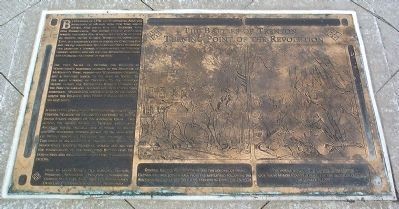The Battle of Trenton Historical Markers, South River Walk Park
Introduction
Text-to-speech Audio
Images
These markers can be found within South River Walk Park.

These markers can be found within South River Walk Park.

These markers can be found within South River Walk Park.

These markers can be found within South River Walk Park.

This is a painting by Emanuel Leutze from 1851 of George Washington and his men crossing the icy Delaware before the Battle of Trenton on Christmas Day 1776.

This is a painting by H. Charles McBarron Jr. from 1975 that is supposed to depict the Battle of Trenton.

This photo shows where the Battle of Trenton took place.

Backstory and Context
Text-to-speech Audio
The Hessian (German) army, under command of the British, had controlled Trenton since December 14, 1776. Beginning in August of that year, General William Howe had been chasing the Continental Army out of New York, and Washington knew he needed a plan or would face defeat. Many of the men in his army had terms set to expire at the end of that year, but Washington asked them to stay on for another six weeks for a final mission. He planned to cross the Delaware River on Christmas Eve and surprise the Hessians under the cover of night with three separate columns. However, the frozen Delaware River made the 19-mile journey more treacherous than initially anticipated. Two of Washington’s columns, under Colonel John Cadwalader and General James Ewing could not make it across, leaving only Washington and his 2,400 men.
When Washington arrived on the morning of December 26, 1776, he split his remaining forces into two columns under General Nathaneal Greene and General John Sullivan. Although Hessians had been warned of the attacks, both by a spy in Washington’s headquarters and deserters from Washington’s army, they were not prepared due to a series of prior false alarms and a mutual belief that there would not be an attack in the harsh storm. Although the Hessians attempted to fight, their commander, Colonel Johann Rall, was shot from his horse and fatally wounded. Around 22 British forces were killed in the attack, 83 were wounded, and over 900 Hessians were captured.
After the battle, the captured Hessians were brought back across the river with Washington, who knew he was unable to hold Trenton. There, they were treated well, and provided information about battle strategies that caused them to lose Trenton, which became vital in the coming days and the Battle of Assunpink Creek. Washington was also informed that 8,000 soldiers under the command of British General Charles Cornwallis and General James Grant were marching south from Princeton. On New Year’s Day, Washington’s 5,000 men returned to Trenton, were they were met by Cornwallis’s army of 5,500. After skirmishes and three attempts to cross the bridge at Assunpink Creek, Cornwallis assumed Washington was trapped, and relented. That night, Washington left 500 men to keep the campfires lit, while the rest of his troops secretly marched to Princeton by extinguishing their torches and muffling their wagon wheels with cloth, where the Battle of Princeton then occurred.
Sources
- Savas, Theodore P., and J. David Dameron. 2010;2006; 2011; A Guide to the Battles of the American Revolution. 1st pbk. ed. New York, N.Y: Savas Beatie.
- Wood, W. J. 1990. Battles of the Revolutionary War, 1775-1781. Vol. 3. Chapel Hill, N.C: Algonquin Books of Chapel Hill.
- Cameron, Henry Clay. 1899. The Battles of Trenton and Princeton. Vol. 4The Macmillan Company.
- Map: Battle of Trenton. George Washington’s Mount Vernon. . Accessed February 03, 2019. https://www.mountvernon.org/preservation/maps/map-battle-of-trenton/.
- Battles of Trenton and Princeton, History. February 6th 2020. Accessed October 16th 2020. https://www.history.com/topics/american-revolution/battles-of-trenton-and-princeton.
- Trenton, American Battlefield Trust. Accessed October 16th 2020. https://www.battlefields.org/learn/revolutionary-war/battles/trenton.
- Battle of Trenton, Visit New Jersey. Accessed October 16th 2020. https://www.visitnj.org/article/battle-trenton.
- 10 Facts about Washington's Crossing of the Delaware River, George Washington's Mount Vernon. Accessed October 16th 2020. https://www.mountvernon.org/george-washington/the-revolutionary-war/washingtons-revolutionary-war-battles/the-trenton-princeton-campaign/10-facts-about-washingtons-crossing-of-the-delaware-river/.
- What Happened to the Captured Hessians?, Washington Crossing Historic Park. January 29th 2020. Accessed October 16th 2020. https://www.washingtoncrossingpark.org/captured-hessians/.
- Nigh, Gary. The Battles of Trenton, Turning Point of the Revolution, Historical Marker Database. November 24th 2019. Accessed October 16th 2020. https://www.hmdb.org/m.asp?m=4274.
By Gary Nigh, November 2007, https://www.hmdb.org/m.asp?m=4274
By Thomas Christopher Anderson, circa 2017, https://www.hmdb.org/m.asp?m=4274
By Gary Nigh, November 2007, https://www.hmdb.org/m.asp?m=4274
By Gary Nigh, November 2007, https://www.hmdb.org/m.asp?m=4274
https://www.battlefields.org/learn/revolutionary-war/battles/trenton
https://www.mountvernon.org/preservation/maps/map-battle-of-trenton/
